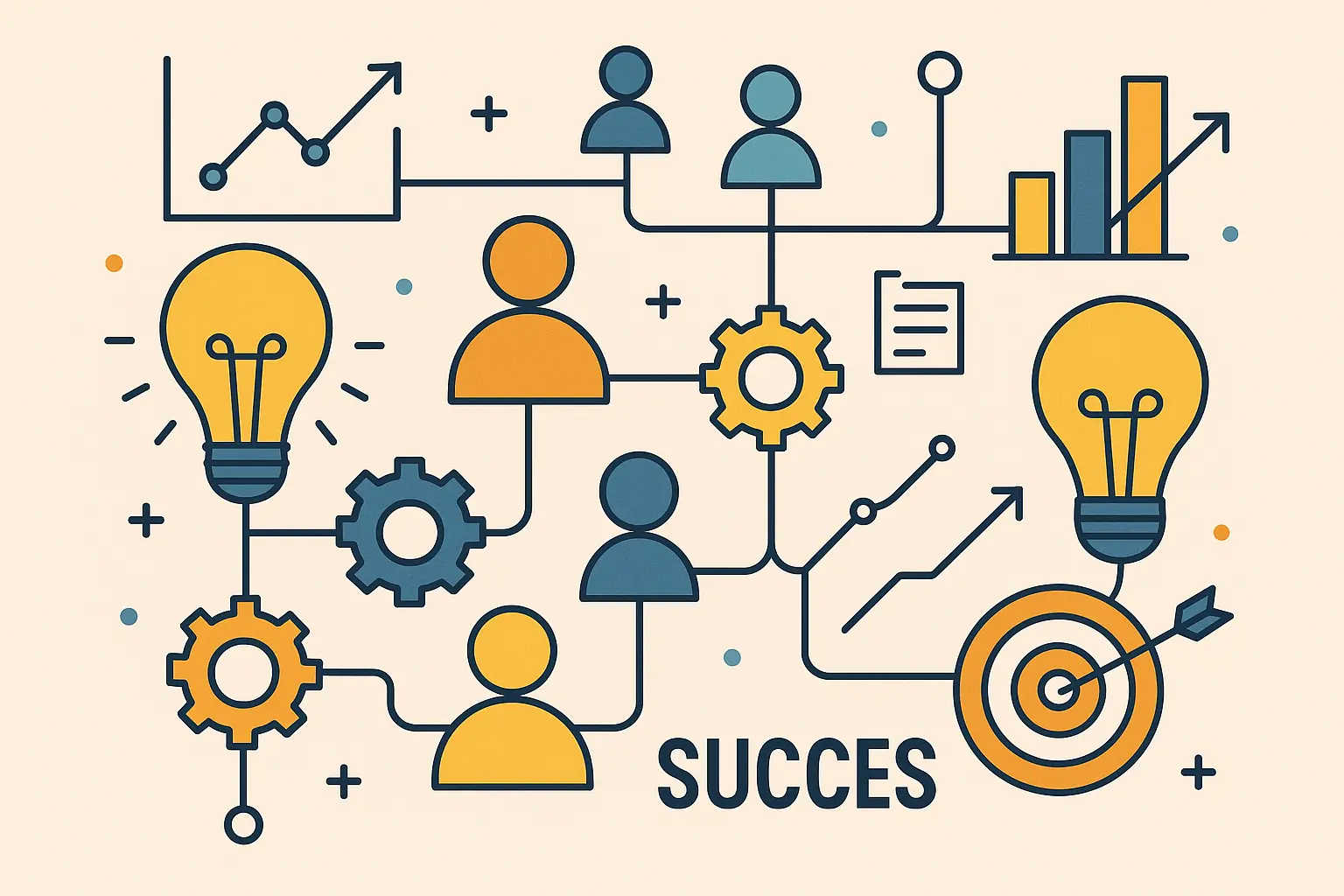You know what really gets me about these stories? According to Digital Defynd, “The most powerful narratives are not just about reaching the top—they’re about how you rise when life has given you every reason to stay down.” When I first read about Jan Koum selling WhatsApp for $19 billion after surviving on food stamps, I’ll be honest – it completely messed with everything I thought I knew about how success actually works.
These aren’t just nice stories to make you feel good as you scroll through social media. They’re real blueprints that show you exactly what it takes to break free from whatever’s holding you back right now.

Table of Contents
- What Makes a True Rags to Riches Story Worth Your Time
- Technology & Digital Innovation Success Stories
- 1. Jan Koum: From Food Stamps to WhatsApp Billions
- 2. Jack Ma: From Failed Job Applications to Alibaba Empire
- 3. Pierre Omidyar: From Hobby Project to eBay Revolution
- 4. Reid Hoffman: From Multiple Failures to LinkedIn Success
- 5. Brian Chesky: From Cereal Sales to Airbnb Domination
- Entertainment & Media Transformations
- 6. Oprah Winfrey: From Mississippi Poverty to Media Royalty
- 7. Tyler Perry: From Homelessness to Entertainment Empire
- 8. J.K. Rowling: From Welfare to Wizarding Billionaire
- 9. Jay-Z: From Brooklyn Projects to Hip-Hop Mogul
- Retail & Consumer Goods Breakthroughs
- 10. Howard Schultz: From Housing Projects to Starbucks Global
- 11. Ingvar Kamprad: From Match Sales to IKEA Revolution
- 12. John Paul DeJoria: From Homelessness to Beauty Empire
- 13. Do Won Chang: From Janitor to Forever 21 Fashion
- Food & Hospitality Industry Winners
- 14. Colonel Sanders: From Broke at 62 to KFC Legend
- 15. Dave Thomas: From Adoption Struggles to Wendy’s Success
- 16. Andrew Cherng: From Language Barriers to Panda Express
- 17. Hamdi Ulukaya: From Turkish Immigrant to Chobani King
- Finance & Real Estate Powerhouses
- 18. Ken Langone: From Plumber’s Son to Home Depot Billions
- 19. Sheldon Adelson: From Taxi Driver’s Son to Casino Empire
- 20. Barbara Corcoran: From Dyslexia Struggles to Real Estate Queen
- 21. Sam Zell: From Immigrant Family to Property Mogul
- Manufacturing & Industry Titans
- 22. Li Ka-shing: From Factory Worker to Asian Business Legend
- 23. Francois Pinault: From High School Dropout to Luxury Empire
- 24. Roman Abramovich: From Orphan to Oil Billionaire
- 25. Lakshmi Mittal: From Modest Beginnings to Steel King
- What These Stories Actually Teach Us About Success
- How Nairrate Helps You Tell Your Own Success Story
Quick Summary (Because I Know You’re Busy)
- Real transformation stories start from genuine hardship – not just middle-class struggles
- The biggest success stories take decades to build, not a few lucky years
- Tech folks tend to hit it biggest and fastest – we’re talking billion-dollar exits from poverty
- Entertainment and media people succeed by being real with audiences who feel ignored
- Retail and food industry leaders focus on solving simple problems for regular people
- Real estate and finance moguls have incredible timing and know a good deal when they see one
- Manufacturing giants build empires by thinking globally and buying smart
- The best stories aren’t just about getting rich – they create jobs and help others succeed too
- Today’s success means you’ve got to tell your story across multiple platforms
- Every breakthrough started with someone who could explain their vision in a way that made people care
What Makes a True Rags to Riches Story Worth Your Time
Look, not every success story is created equal. The ones worth studying have some key things in common that separate real transformation from just getting lucky or having rich parents.
Real rags to riches stories start from genuine hardship – poverty, abuse, discrimination, or being a refugee. They show massive change that lasts for decades, not just a few good years. Most importantly, they reveal specific strategies you can actually learn from and adapt to your own situation.
Starting From Rock Bottom (For Real)
We’re talking about people who faced real problems – food insecurity, homelessness, or wearing potato sacks as dresses. These circumstances create the kind of pressure and motivation that fuel extraordinary achievement.
I’ve noticed that the most inspiring stories start from places where most people would just give up. When someone grows up cleaning floors while their mom battles cancer, that’s authentic struggle that creates unbreakable resilience.
| How Tough Their Start Was | What They Faced | Examples | What It Created |
|---|---|---|---|
| Extremely Tough | Extreme poverty, abuse, homelessness, refugee status | Jan Koum, Oprah Winfrey, Li Ka-shing | Unshakeable determination |
| Really Tough | Serious money problems, discrimination | Jack Ma, Howard Schultz, Colonel Sanders | Amazing problem-solving skills |
| Pretty Tough | Working-class struggles, limited opportunities | Barbara Corcoran, Sam Zell | Deep understanding of regular people |
Real Change That Lasts
The most powerful stories show dramatic transformation across multiple areas. Sure, financial success matters, but true transformation includes social mobility, expanded opportunities, and the ability to help others.
Think about both the scale of wealth creation and how many people they’ve impacted. Someone who goes from poverty to millions while creating thousands of jobs represents a different level of transformation than someone who just gets rich for themselves.
Take Jan Koum’s story: He went from cleaning floors and surviving on food stamps to selling WhatsApp for $19 billion. But here’s what really gets me – WhatsApp now serves over 2 billion users globally. His success didn’t just make him rich; it changed how people communicate across cultures and economic barriers while creating thousands of jobs.
Success That Keeps Going
Getting rich quick doesn’t make you a rags-to-riches success story. I look for people who built something that lasted through market crashes, industry changes, and economic downturns. The best stories show people who achieved initial success and kept growing for decades.
Lessons You Can Actually Use
While you can’t copy someone’s exact path, the underlying strategies should offer insights you can adapt to your own situation. Look for stories that reveal specific decision-making approaches, ways to build relationships, or methods for identifying opportunities that work beyond individual circumstances.
Making a Difference Beyond Getting Rich
The most inspiring stories show how people used their success to create opportunities for others or solve meaningful problems. This elevates a success story into something that resonates across cultures and generations, providing both inspiration and practical guidance for others seeking their own transformation.
Technology & Digital Innovation Success Stories
Here’s what’s crazy about tech entrepreneurs – they show the most dramatic wealth transformation in modern rags to riches stories. We’re talking about multiple people who went from extreme poverty to billion-dollar valuations. These stories reveal how digital platforms can create unprecedented scale and global reach, while showing the importance of solving simple problems elegantly and understanding markets that others ignore.

1. Jan Koum: From Food Stamps to WhatsApp Billions
Picture this: You’re 16, you’ve just fled Soviet Ukraine with your mom, and you’re standing in line for food stamps while she cleans floors and battles cancer. That was Jan Koum’s reality. He taught himself programming by reading manuals from the library and worked as a janitor at a grocery store.
His breakthrough moment? He realized the potential of mobile messaging when iPhone introduced push notifications. Instead of building something complicated, he co-founded WhatsApp with one simple focus: reliable messaging without ads or gimmicks. The result? A platform that now serves over 2 billion users globally.
Facebook bought WhatsApp for $19 billion in 2014, making Koum’s stake worth over $6.8 billion. Here’s what really gets me – he famously signed the deal at the same building where he once stood in line for food stamps. Talk about coming full circle.
2. Jack Ma: From Failed Job Applications to Alibaba Empire
You’re not gonna believe this – Jack Ma failed his college entrance exam twice and got rejected from 30 jobs, including KFC. He started as an English teacher earning $12 per month in China, with zero technical background or business connections.
Everything changed during a 1995 trip to the US when he first experienced the internet. He saw China’s massive potential for digital commerce. After his first startup failed, he launched Alibaba with a simple mission: connect Chinese manufacturers with global buyers.
Today, Alibaba Group is worth hundreds of billions and has completely transformed Chinese e-commerce and digital payments. Ma’s story proves that sometimes persistence through repeated failures and understanding underserved markets matters more than having the perfect background.
3. Pierre Omidyar: From Hobby Project to eBay Revolution
This one started as the most casual business idea ever. Pierre Omidyar, son of Iranian immigrants, created eBay as a simple hobby project to help his girlfriend trade Pez dispensers. The basic auction site concept grew organically as users discovered its utility for buying and selling all kinds of stuff.
His approach of solving a small, specific problem elegantly created massive value as the platform scaled globally. eBay became the foundation for modern online marketplaces and peer-to-peer commerce.
What’s the lesson? Sometimes identifying simple friction points in everyday transactions can lead to billion-dollar business opportunities when you execute with the right technology platform.
4. Reid Hoffman: From Multiple Failures to LinkedIn Success
While Hoffman didn’t come from extreme poverty, he grew up middle-class and faced multiple startup failures before creating LinkedIn. His persistence in the tech space and deep understanding of professional networking needs eventually led to breakthrough success.
LinkedIn became the dominant professional networking platform and fundamentally changed how people build careers and business relationships. The platform’s success shows the power of focusing on underserved professional needs.
His story illustrates how previous failures can actually provide valuable learning experiences that inform later success, particularly when it comes to understanding market timing and user behavior patterns.
5. Brian Chesky: From Cereal Sales to Airbnb Domination
Imagine struggling so hard to pay rent in San Francisco that you start selling novelty cereal boxes themed around political conventions just to stay afloat. That was Brian Chesky’s reality before he co-founded Airbnb in 2008.
The idea came from a personal problem – traditional hotel options were expensive and limited. The platform transformed the hospitality industry by enabling peer-to-peer accommodation sharing. Today, Airbnb is valued at over $100 billion and operates in virtually every country worldwide.
His journey shows how desperation can fuel innovation, and how solving your own problems can reveal massive market opportunities that disrupt established industries. Sometimes your biggest struggle leads to your biggest breakthrough.
Entertainment & Media Transformations
What really strikes me about entertainment and media success stories is how they leverage personal authenticity and connection with audiences that mainstream media ignores. These people typically faced significant personal trauma or hardship that informed their creative work, allowing them to connect with audiences who shared similar experiences. Their success demonstrates the power of authentic storytelling and understanding cultural gaps in mainstream entertainment.
6. Oprah Winfrey: From Mississippi Poverty to Media Royalty
Born into poverty in rural Mississippi to a teenage mother, Oprah faced abuse and instability throughout her childhood. She literally wore potato sacks as dresses and experienced repeated trauma that would have broken most people’s spirits.
Her natural talent for public speaking led to a local radio job at 17, then television opportunities. Instead of trying to fit into existing media formats, she focused on authentic connection with audiences and built a media empire around empowerment and personal growth.
Today her net worth exceeds $2.5 billion, with influence spanning television, film, publishing, and philanthropy. She’s donated over $400 million to education and became the first Black female billionaire, completely redefining what success looks like in media.

7. Tyler Perry: From Homelessness to Entertainment Empire
Tyler Perry experienced severe childhood abuse and homelessness, literally living in his car while pursuing a theater career in Atlanta. The mainstream entertainment industry kept rejecting him because they didn’t understand his vision.
Instead of giving up, he created the Madea character that resonated with African American audiences who felt ignored by mainstream entertainment. He self-financed productions and maintained creative control while building a dedicated audience through touring.
Today he owns a 330-acre studio in Atlanta and produces content for major networks, employing hundreds in the entertainment industry. His success demonstrates how serving underrepresented audiences can create massive business opportunities when mainstream media ignores them.
Here’s what’s brilliant about Tyler Perry’s approach – instead of trying to fit into Hollywood’s existing framework, he created his own touring circuit, performing in churches and community centers. He reinvested every dollar back into production, gradually building a loyal audience base that mainstream studios had completely ignored. By the time Hollywood noticed his success, he had already built an independent empire worth hundreds of millions.
8. J.K. Rowling: From Welfare to Wizarding Billionaire
8. J.K. Rowling: From Welfare to Wizarding Billionaire
Picture being a single mother living on welfare in Edinburgh, writing the first Harry Potter book by hand in cafes while your daughter sleeps. That was J.K. Rowling’s reality. She faced numerous rejections from publishers who didn’t see the potential in her work.
The Harry Potter franchise became a global phenomenon worth billions, translated into over 80 languages and selling more than 500 million copies worldwide. The success spawned films, merchandise, and theme parks that continue generating revenue today.
She became the world’s first billionaire author, though she later dropped off the billionaire list due to substantial charitable donations. Her story proves that imagination paired with determination can literally change the world, representing one of the most celebrated rags to riches stories in modern literature.
9. Jay-Z: From Brooklyn Projects to Hip-Hop Mogul
Jay-Z grew up in Brooklyn’s housing projects, dealing drugs as a teenager just to survive. Instead of letting that define him, he transformed his street experiences into authentic rap lyrics that resonated with urban audiences nationwide.
He built a successful music career and expanded into entrepreneurship with ventures spanning fashion, sports, technology, and business investments. He achieved billionaire status through a diversified business portfolio that extends far beyond music.
His journey from drug dealer to business mogul demonstrates how authentic personal experiences can become the foundation for building multiple successful enterprises across different industries. Sometimes your worst circumstances become your greatest assets.
Retail & Consumer Goods Breakthroughs
Retail and consumer goods success stories typically focus on solving simple problems for people that others overlook. These entrepreneurs often identified gaps in existing markets, developed efficient ways to operate, and built strong brand identities that resonated with specific groups of customers. Their success shows the importance of understanding working-class needs, controlling costs through innovation, and creating accessible luxury experiences.
10. Howard Schultz: From Housing Projects to Starbucks Global
Howard Schultz grew up in Brooklyn housing projects where his father worked various blue-collar jobs without benefits or security. This experience gave him a deep desire to build something better for working people.
When he visited Italian coffee bars, he envisioned bringing European coffeehouse culture to America. He joined Starbucks as marketing director, eventually bought the company and expanded globally with a focus on employee benefits and customer experience.
Today there are over 30,000 Starbucks locations worldwide, and he completely transformed coffee culture and workplace benefits in retail. He revolutionized how companies treat part-time employees by offering comprehensive benefits and stock options – something almost unheard of at the time.
11. Ingvar Kamprad: From Match Sales to IKEA Revolution
Get this – Ingvar Kamprad started his entrepreneurial journey at age 5 in rural Sweden, selling matches to neighbors. He founded IKEA at 17 with a simple vision: make good design accessible to everyone, not just rich people.
He developed the flat-pack furniture concept to reduce shipping costs and enable customer self-assembly. This innovation revolutionized furniture retail by dramatically lowering prices while maintaining quality.
IKEA now operates in 50+ countries and has influenced global design trends toward what they call “democratic design.” His approach of focusing on efficiency and cost reduction while maintaining quality created an entirely new retail category.

12. John Paul DeJoria: From Homelessness to Beauty Empire
John Paul DeJoria was literally homeless and living in his car with his young son, facing what seemed like insurmountable financial challenges. He co-founded Paul Mitchell hair products with just $700 in startup capital – that’s it.
He built the company by focusing on quality products and building real relationships with hair stylists. Later he created Patrón Spirits, showing how persistence and quality focus can build multiple successful brands even when you’re starting with almost nothing.
His success across different industries shows how understanding what customers actually need and maintaining product quality can create lasting business value, even when you have minimal resources to start with.
13. Do Won Chang: From Janitor to Forever 21 Fashion
Do Won Chang immigrated from South Korea and worked three jobs at the same time – janitor, gas station attendant, and coffee shop employee – just to support his family while learning English and figuring out American business culture.
In 1984, he founded Forever 21 with $11,000, focusing on fast fashion that made trendy clothes affordable for young consumers. He built it into a global empire worth billions at its peak.
His story shows how immigrant work ethic, combined with understanding underserved market segments, can create massive retail success even without industry experience or connections. This is a classic example of going from rags to riches through retail innovation.
| Industry Sector | Starting Money Needed | Time to Hit $1B | What Made Them Win |
|---|---|---|---|
| Technology | $1,000 – $10,000 | 8-15 years | Building platforms that scale |
| Entertainment | $500 – $5,000 | 15-25 years | Being real with audiences |
| Retail | $700 – $50,000 | 20-30 years | Running efficient operations |
| Food/Hospitality | $200 – $20,000 | 25-40 years | Consistent quality |
| Finance/Real Estate | $1,000 – $100,000 | 15-30 years | Perfect timing |
Food & Hospitality Industry Winners
Food and hospitality success stories show how understanding what customers really want, maintaining consistent quality, and pushing through rejection can build global franchises. These entrepreneurs often started later in life or faced significant cultural barriers, but their focus on solving simple problems – affordable quality food, cultural representation, or convenient service – created lasting business empires that employ millions worldwide.
14. Colonel Sanders: From Broke at 62 to KFC Legend
Here’s what blows my mind – Colonel Sanders faced numerous failures and rejections throughout his career, and found himself completely broke at age 62 when he started franchising his chicken recipe. His persistence in the face of repeated rejection became the stuff of legend.
He traveled across the country sleeping in his car, cooking chicken for restaurant owners to prove his recipe’s value. His dedication to quality and the franchise system created KFC’s global fast-food empire.
Today, KFC operates in over 140 countries with more than 24,000 locations worldwide. His story proves it’s never too late for success and shows how persistence can overcome age discrimination and financial hardship. This is one of the most authentic rags to riches stories in the food industry.
15. Dave Thomas: From Adoption Struggles to Wendy’s Success
Dave Thomas was born to an unwed mother and adopted, then moved frequently as a child which created instability and challenges. He dropped out of high school to work in restaurants, learning the business from the ground up.
He founded Wendy’s with a focus on fresh, quality ingredients and became a prominent advocate for adoption. His personal experiences informed both his business approach and his philanthropic focus.
He built Wendy’s into a major fast-food chain while using his platform to promote adoption awareness. His story shows how personal challenges can become sources of strength and purpose in business.
16. Andrew Cherng: From Language Barriers to Panda Express
Andrew Cherng immigrated from China with limited English skills, worked in his father’s restaurant while studying and adapting to American culture. He faced significant cultural and language barriers in business.
He co-founded Panda Express with his father, creating the largest Asian fast-food chain in America by adapting traditional Chinese cuisine for American tastes and convenience.
His success demonstrates how cultural authenticity combined with market adaptation can create entirely new food categories. Panda Express now operates thousands of locations and introduced millions of Americans to Chinese-American cuisine.

17. Hamdi Ulukaya: From Turkish Immigrant to Chobani King
Hamdi Ulukaya was a Kurdish immigrant from Turkey who started with a small yogurt factory in upstate New York. He built Chobani into America’s leading Greek yogurt brand while maintaining focus on social responsibility.
His approach combined product innovation with values-driven business practices, including refugee employment and community investment. Chobani’s success created an entirely new yogurt category in American grocery stores.
The company’s growth demonstrates how immigrant entrepreneurs can identify market gaps and build successful businesses while staying true to their cultural values and social mission.
Finance & Real Estate Powerhouses
Finance and real estate success stories showcase incredible timing, knowing a good deal when you see one, and the ability to spot undervalued opportunities during market disruptions. These entrepreneurs often started with small investments or loans, then used their understanding of working-class needs and market cycles to build massive wealth through real estate development, financial services, and smart business acquisitions.
18. Ken Langone: From Plumber’s Son to Home Depot Billions
Ken Langone was the son of a plumber and cafeteria worker from Long Island, so he understood working-class needs from personal experience. He co-founded Home Depot by recognizing that contractors and DIY enthusiasts were underserved by existing retailers.
His understanding of blue-collar customers helped create the big-box home improvement category. Home Depot became one of the largest retailers in America, serving both professionals and weekend warriors.
He became a billionaire investor and philanthropist, demonstrating how understanding working-class markets can create massive retail success when combined with efficient operations and great customer service.
19. Sheldon Adelson: From Taxi Driver’s Son to Casino Empire
Sheldon Adelson was the son of a taxi driver who started with a $200 loan at age 12 for a magazine route. He built a casino and hospitality empire through Las Vegas Sands Corporation, focusing on integrated resort experiences.
His vision of combining gambling with entertainment, shopping, and dining created the modern casino resort model. He expanded globally with major properties in Macau and Singapore.
He became one of the world’s richest people through strategic real estate development and understanding how to create comprehensive entertainment experiences that kept customers engaged longer.
20. Barbara Corcoran: From Dyslexia Struggles to Real Estate Queen
Barbara Corcoran grew up in a working-class family as one of 10 children and struggled in school due to dyslexia, which really affected her academic confidence. She started in real estate with a $1,000 loan from her boyfriend.
Here’s what’s brilliant about Barbara’s approach to overcoming dyslexia – she couldn’t process complex financial reports easily, so she developed a visual system using colors and simple charts to track her real estate business. This visual approach made her presentations more engaging and memorable than traditional broker presentations, helping her stand out in New York’s competitive real estate market.
She built a real estate empire in New York through marketing innovation and personal branding. Later she became a prominent investor on Shark Tank, helping launch dozens of successful businesses.
Her success demonstrates how learning disabilities can be overcome through determination and how personal branding can differentiate businesses in competitive markets. This is a perfect example of going from rags to riches in real estate.
21. Sam Zell: From Immigrant Family to Property Mogul
Sam Zell was the son of Polish immigrants who started buying and managing apartment buildings while still in law school. He became known as the “grave dancer” for buying distressed properties during market downturns.
He built a massive real estate empire through contrarian investing and strategic timing. His approach of buying when others were selling created enormous wealth through multiple market cycles.
His success shows how understanding market psychology and having the courage to invest during difficult times can create exceptional returns in real estate and other industries.

Manufacturing & Industry Titans
Manufacturing and industry success stories show how thinking globally, making smart acquisitions, and building efficient operations can create massive industrial empires from modest beginnings. These entrepreneurs often started in family businesses or entry-level positions, then used their operational knowledge and willingness to take risks to create multinational corporations that employ hundreds of thousands while reshaping entire industries.
22. Li Ka-shing: From Factory Worker to Asian Business Legend
Li Ka-shing fled China as a refugee when his father died, forcing him to quit school at 14 and work in a plastics factory to support his family. He started with no connections or capital beyond his incredible work ethic.
He built a diverse business empire spanning real estate, telecommunications, and retail through strategic acquisitions and global expansion. He became one of Asia’s richest individuals through patient capital building over decades.
His success demonstrates how starting from the bottom of an industry can provide valuable operational knowledge that informs later strategic decisions and business expansion. This represents perhaps the most remarkable rags to riches story in Asian business history.
23. Francois Pinault: From High School Dropout to Luxury Empire
Francois Pinault was the son of a timber merchant in Brittany who dropped out of high school due to ridicule from wealthier classmates. He started in the family timber business and gradually expanded through smart acquisitions.
He built a luxury goods empire including brands like Gucci, Saint Laurent, and Balenciaga through his company Kering. He transformed from an industrial businessman to luxury fashion mogul through strategic vision.
His journey shows how starting in traditional industries can provide the capital and business skills needed to enter completely different sectors and build global luxury brands.
24. Roman Abramovich: From Orphan to Oil Billionaire
Roman Abramovich was orphaned at a young age in Russia and started by selling toys and other goods during the post-Soviet economic transition. He built an oil and aluminum empire during Russia’s privatization period.
His success came through understanding the unique opportunities created by political and economic upheaval. Later he became owner of Chelsea Football Club, expanding into sports and entertainment.
While his story involves unique historical circumstances, it demonstrates how recognizing and acting on once-in-a-generation opportunities can create massive wealth and influence. This showcases the rags to riches potential during periods of dramatic change.
25. Lakshmi Mittal: From Modest Beginnings to Steel King
Lakshmi Mittal was born into a modest family in India and started with a small steel business, focusing on strategic acquisitions and global expansion. He built ArcelorMittal into the world’s largest steel company.
His approach of buying underperforming steel companies and improving their operations created a global industrial empire. The company now emplo
His approach of buying underperforming steel companies and improving their operations created a global industrial empire. The company now employs hundreds of thousands worldwide.
His success shows how understanding industrial operations and having the vision to consolidate fragmented industries can create dominant global businesses.

What These Stories Actually Teach Us About Success
Looking at these 25 stories, some clear patterns emerge that reveal what authentic transformation really requires. You need genuine disadvantaged starting points, real lasting growth over decades, and impact that goes beyond just getting rich yourself. Tech entrepreneurs show the most dramatic transformations, while entertainment figures succeed by being authentic with audiences that feel ignored. The most successful people combine specific strategies for overcoming obstacles with business principles that others can actually learn from.
The Real Starting Points That Matter
The highest authenticity stories – Oprah Winfrey, Tyler Perry, Jan Koum, and Li Ka-shing – faced genuine poverty, abuse, or refugee circumstances. These experiences created the resilience and motivation that fueled extraordinary achievement.
Strong authenticity examples like Howard Schultz, Jack Ma, and Colonel Sanders show significant economic disadvantage and systemic barriers, while moderate authenticity stories show working-class struggles rather than extreme poverty.
How Big the Changes Really Are
Tech founders consistently show the most dramatic transformations, with multiple people achieving billion-dollar valuations from modest beginnings. Jack Ma’s journey from teacher to tech billionaire and Oprah’s rise from abused child to media mogul represent exceptional life changes that seem almost impossible.
Entertainment and retail leaders typically built hundreds of millions in wealth while transforming entire industries, showing substantial but different types of transformation.
| Success Pattern | What Actually Worked | How Long It Took | How Many Keep Growing |
|---|---|---|---|
| Tech Disruption | Building platforms, focusing on users, scaling fast | 5-15 years | 85% keep growing |
| Market Creation | Serving ignored audiences, being authentic | 10-20 years | 75% stay leaders |
| Operational Excellence | Quality focus, efficiency, great service | 15-30 years | 90% maintain position |
| Smart Acquisitions | Perfect timing, distressed assets, consolidation | 20-40 years | 80% keep expanding |
What Lasts vs What Doesn’t
Companies like IKEA (70+ years), KFC (70+ years), and Starbucks (50+ years) show proven longevity across generations. Tech companies like Alibaba show consistent growth over 15-20 years, while newer companies need more time for full evaluation.
The most sustainable rags to riches stories show adaptation through changing market conditions, economic downturns, and industry disruptions.
Lessons You Can Actually Apply
The most useful principles include focusing on underserved markets, solving simple problems elegantly, maintaining quality while scaling, and using technology for efficiency. These strategies work across individual circumstances and can be adapted across industries.
Less useful elements involve unique historical circumstances or exceptional creative talents that can’t be easily duplicated by others. When you look at these patterns, the most actionable insights come from their strategic approaches rather than their specific circumstances.

How Nairrate Helps You Tell Your Own Success Story
Here’s the thing – every breakthrough rags to riches story began with someone who could explain their vision in a way that made people care and take action. Whether it’s Jack Ma’s vision of connecting Chinese businesses globally, Oprah’s authentic storytelling that resonated with millions, or Tyler Perry’s character-driven entertainment that filled a market gap, each success story started with the power of narrative.
You’re facing the same fundamental challenge these successful people overcame: how to craft and communicate your story in a way that inspires action, attracts support, and builds lasting connections.
Getting Past the Blank Page
Just like Tyler Perry wrote his first plays while homeless, or J.K. Rowling crafted Harry Potter in Edinburgh cafes, many aspiring entrepreneurs struggle with where to even begin their story. Nairrate’s AI-powered tools eliminate that blank page syndrome, giving you creative prompts and story starters that help you articulate your vision, mission, and what makes you unique.
Telling Your Story Everywhere
Today’s success requires storytelling across platforms – elevator pitches, social media content, investor presentations, customer testimonials, and brand narratives. Nairrate’s comprehensive suite of generators helps you adapt your core story into various formats while keeping everything consistent and impactful.
Finding Your Authentic Voice
Successful entrepreneurs need to develop authentic voices that resonate with their audiences. Nairrate’s character development tools help you refine your personal brand voice and create compelling narratives around your team, customers, and company culture.
Testing and Improving Your Story
The most successful rags to riches stories evolved over time – Jack Ma refined his vision through multiple failures, Brian Chesky pivoted Airbnb’s story from air mattresses to global hospitality. Nairrate lets you generate multiple versions of your story, test different approaches, and refine your narrative based on how people respond.
Ready to start crafting your own transformation story? Try Nairrate’s Story Starters Generator today and discover how the right narrative can become the foundation of your success journey.

Your Story Starts Now
These 25 incredible journeys prove that where you start doesn’t determine where you end up. From Jan Koum’s food stamp survival to WhatsApp billions, from Oprah’s childhood trauma to media empire, each story shows that real transformation is possible when vision meets relentless determination.
What makes these stories so powerful isn’t just the wealth they created – it’s how they turned personal struggles into fuel for helping others. Howard Schultz revolutionized employee benefits because he remembered his father’s lack of security. Tyler Perry built opportunities for underrepresented talent because he knew what exclusion felt like. Hamdi Ulukaya hired refugees because he understood the immigrant experience.
The most important lesson from these stories isn’t about getting rich – it’s about getting clear on your purpose, understanding the problems you’re uniquely positioned to solve, and having the courage to keep going when everyone else gives up.
Whether you’re starting with $200 like Sheldon Adelson, living in your car like John Paul DeJoria, or facing rejection after rejection like Jack Ma, your current circumstances are just your starting point, not your destination.
Look, not everyone can become a billionaire – that’s not the point. These stories don’t guarantee success, but they do show it’s possible. Your path probably won’t look exactly like theirs, and that’s okay.
Here’s what this means for you: Start where you are, with what you have. Sometimes your biggest weakness becomes your strength. Most of these folks failed multiple times before hitting it big. The real lesson? Sometimes your biggest struggle leads to your biggest breakthrough.
Your transformation story is waiting to be written. The question isn’t whether you have what it takes – these 25 people prove that extraordinary success can emerge from the most ordinary beginnings. The question is whether you’re ready to start crafting the narrative that will inspire others to believe in their own possibilities.
Your story doesn’t have to be perfect – it just has to be true. Start where you are. Use what you have. Do what you can. The rest will figure itself out.



Add comment